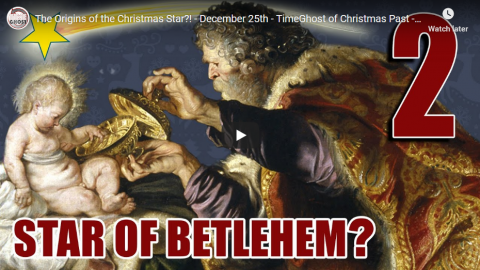TimeGhost History
Published 27 Dec 2019Did you go to the cinema this holiday? Or binge a bit of streaming? D’you feel modern about it? You’d be wrong… Holiday movies is a tradition that goes back almost 125 years!
Join us on Patreon: https://www.patreon.com/TimeGhostHistory
Hosted by: Indy Neidell
Written by: Spartacus Olsson
Directed by: Spartacus Olsson and Astrid Deinhard
Executive Producers: Bodo Rittenauer, Astrid Deinhard, Indy Neidell, Spartacus Olsson
Creative Producer: Joram Appel
Post-Production Director: Wieke Kapteijns
Research by: Spartacus Olsson
Edited by: Mikołaj Cackowski
Sound design: Marek KamińskiSources:
Mark Doliner https://flic.kr/p/oV46FY
Portrait of the Actress Carrie Fisher member of the jury in the 70 Edition of Venice International Film Festival 2013 by Riccardo GhilardiSoundtracks from Epidemic Sound:
Howard Harper-Barnes – “A Sleigh Ride Into Town”
Howard Harper-Barnes – “My Only Wish Is Love”
Mike Franklyn – “Christmas Bliss”
The Snowy Hill Singers – “It Was On A Christmas Night” (Instrumental Version)A TimeGhost chronological documentary produced by OnLion Entertainment GmbH.
December 28, 2019
Star Wars and the First Xmas Film – December 27th – TimeGhost of Christmas DAY 4
American railways are simultaneously world-beating and terrible
That’s because, as Sean Smith and Peter Earle point out, there are two very different entities running on America’s rails:

Burlington Northern Santa Fe (BNSF) locomotive 5399, Kansas City Southern (KCS) 4807, and 1890 westbound on the BNSF Emporia Sub near Timberland Blvd West of Northgate Street in Olathe, Kansas.
Photo by Tyler Silvest via Wikimedia Commons.
American railways are the envy of the world.
Many might shake a collective head at that statement. In the case of passenger rail that is an appropriate reaction. Since it was pieced together – a government-constructed Franken-rail system built of numerous bankrupt railways which were essentially nationalized – Amtrak has been a reliable money sink, losing tens of billions of dollars since 1970.
Any traveler that has used Amtrak to any significant extent has firsthand experience with the crumbling infrastructure, frequent delays, and general unpleasantness that accompanies U.S. passenger rail service. Even the oft-cited bright spot of Amtrak, the “high speed” Acela system (which shuttles between Boston and Washington D.C) pales in comparison when compared to high-end passenger rail systems in Western Europe, Japan, and China.
Bullet trains routinely travel at least 200 mph, whereas Acela trundles along at a pedestrian 84 mph, and there is no indication (and probably no intention) of that gap closing anytime soon.
U.S. passenger rail services in general are money-losing and antiquated versus their global counterparts, an inarguable (and to public transport proponents, embarrassing) fact. Passenger rail is just one part of the story, and serves as an excellent example of how not to manage a rail system. In fairness, efforts to turn Amtrak around (mainly through aggressive cost cutting) do seem to be having an impact, as current year losses total a shade under $30 million. It’s an admirable effort to be sure, but decades of losses, poor service, and general mismanagement cannot be ignored.
The U.S. freight railway system, conversely, is the envy of the world, and this is not hyperbole or chest thumping; the facts back it up. Since the Staggers Act of 1980, which deregulated freight rail, improvements have been substantial. U.S. freight railways carry 81% more ton-miles of freight, and costs have fallen 46%. (It isn’t common for an industry to increase its capacity by 81% while reducing costs by nearly half.) That level of success has even been noted by the Community of European Railway and Infrastructure Companies, which might be surprising, given the common assumption that Europe has a monopoly on rail excellence.
Compared side by side, it seems a conundrum: Amtrak limps along, still relying upon billions of dollars worth of taxpayer-financed subsidies, while U.S. freight railways evince growing profitability and capacity amid rapidly falling costs. Why are U.S. freight rails so profitable when U.S. passenger rail – sometimes traveling the same routes, on some of the same rails – remains a perennial money pit?
Shpagin’s Simplified Subgun: The PPSh-41
Forgotten Weapons
Published 15 Dec 2017http://www.patreon.com/ForgottenWeapons
Cool Forgotten Weapons merch! http://shop.bbtv.com/collections/forg…
After making the decision to mass produce a submachine gun, the Soviet Union adopted the Degtyarev PPD-38 and PPD-40, but this design was too expensive for the huge scale of production that the USSR intended. A new design was needed, and was put into development almost as soon as the PPD was entering production.
Shpagin won the design competition with the PPSh-41, a weapon which required virtually no lathe work at all. It was assembled from a combination of heavy-gauge stampings and simple milled parts, and it fit the Soviet requirements quite well. Shpagin retained the high rate of fire and large drum magazines from the PPD, and even had a semiauto selector switch in his submachine gun, a bit unusual in a weapon intended for minimum expense.
The drum magazines proved to be the weak point of the design, being only somewhat interchangeable between weapons and being rather complex to manufacture as well as bulky to carry and fairly easy to damage. A 35-round box magazine was introduced later on which ameliorated some of these issues, although not all of them. The PPSh-41 would go on to be deemed itself too complex, and supplemented by the PPS-43 submachine gun, although it was never fully replaced during World War Two. In addition to Soviet service, it would be copied and manufactured by several other nations.
Thanks to Marstar for letting me examine and shoot their PPSh-41!
If you enjoy Forgotten Weapons, check out its sister channel, InRangeTV! http://www.youtube.com/InRangeTVShow
QotD: The “missing” mass of the universe
For something to exist, it has to be observed.
For something to exist, it has to have a position in time and space.
And this explains why nine-tenths of the mass of the universe is unaccounted for.
Nine-tenths of the universe is the knowledge of the position and direction of everything in the other tenth. Every atom has its biography, every star its file, every chemical exchange its equivalent of the inspector with a clipboard. It is unaccounted for because it is doing the accounting for the rest of it, and you cannot see the back of your own head.*
Nine-tenths of the universe, in fact, is the paperwork.
* Except in very small universes.
Terry Pratchett, Thief of Time, 2001.
December 27, 2019
“Panzer Battalion” – The Iraq War – Sabaton History 047 [Official]
Sabaton History
Published 26 Dec 2019An American-led coalition invaded Iraq in 2003. Sabaton’s song “Panzer Battalion” is about that attack and in this episode, Indy talks about the fight and its consequences.
Support Sabaton History on Patreon: https://www.patreon.com/sabatonhistory
Listen to Primo Victoria (where “Panzer Battalion” is featured):
CD: http://bit.ly/PrimoVictoriaStore
Spotify: http://bit.ly/PrimoVictoriaSpotify
Apple Music: http://bit.ly/PrimoVictoriaAppleMusic
iTunes: http://bit.ly/PrimoVictoriaiTunes
Amazon: http://bit.ly/PrimoVictoriaAmzn
Google Play: http://bit.ly/PrimoVictoriaGooglePlayListen to Sabaton on Spotify: http://smarturl.it/SabatonSpotify
Official Sabaton Merchandise Shop: http://bit.ly/SabatonOfficialShopHosted by: Indy Neidell
Written by: Markus Linke and Indy Neidell
Directed by: Astrid Deinhard and Wieke Kapteijns
Produced by: Pär Sundström, Astrid Deinhard and Spartacus Olsson
Creative Producer: Joram Appel
Executive Producers: Pär Sundström, Joakim Broden, Tomas Sunmo, Indy Neidell, Astrid Deinhard, and Spartacus Olsson
Post-Production Director: Wieke Kapteijns
Edited by: Iryna Dulka
Sound Editing by: Marek Kaminski
Maps by: Eastory – https://www.youtube.com/c/eastoryArchive by: Reuters/Screenocean https://www.screenocean.com
Music by Sabaton.An OnLion Entertainment GmbH and Raging Beaver Publishing AB co-Production.
© Raging Beaver Publishing AB, 2019 – all rights reserved.
A Christmas 2.0? – Kwanzaa – December 26th – TimeGhost of Christmas Past – DAY 3
TimeGhost History
Published 26 Dec 2019It is in the Civil Rights Movement of the 1960s, that a young doctor of African studies decides to create his own holiday in California. Half a century later and this holiday has now become the nation-wide Kwanzaa.
Join us on Patreon: https://www.patreon.com/TimeGhostHistory
Hosted by: Indy Neidell
Written by: Rune Væver Hartvig and Spartacus Olsson
Directed by: Spartacus Olsson and Astrid Deinhard
Executive Producers: Bodo Rittenauer, Astrid Deinhard, Indy Neidell, Spartacus Olsson
Creative Producer: Joram Appel
Post-Production Director: Wieke Kapteijns
Research by: Rune Væver Hartvig
Edited by: Mikołaj Cackowski
Sound design: Marek KamińskiColorization by:
Julius Jääskeläinen – https://www.facebook.com/JJcolorization/Sources:
valphotography https://flic.kr/p/6yoUEF
Emilio Labrador https://flic.kr/p/65sBT1
Robert Couse-Baker https://flic.kr/p/b2oyrr
Boston City Archives
From the Noun Project:
umoja by Travis Avery
kinara by Travis Avery
Human by AngelinaSoundtracks from Epidemic Sound:
Howard Harper-Barnes – “A Sleigh Ride Into Town”
Zauana – “Encountering the Unknown”
Sahara Skylight – “Streams of Africa”
Sahara Skylight – “Arriving in Ghana”
Sight of Wonders – “Wildlife Sunrise”A TimeGhost chronological documentary produced by OnLion Entertainment GmbH.
From the comments:
TimeGhost History
17 minutes ago
Today, December 26, our TimeGhost of Christmas Past looks back in the not-too-distant history – in fact into a time in history when some of us here were alive. See, in 1966, Dr. Maulana Karenga decides to create his own holiday in the midst of the holiday season, and, as you’ll see, the rest is history. Now, before some of you become all judgemental and begin shouting in the comment section, remember what Indy says in the video. Think twice before you write something, and please adhere to our community guidelines. And even if you have something controversial to say or not, we’d still like you to share some holiday cheer with us by supporting us on Patreon. It is because of our Patreons that we can fly back into the past and their contributions are vital. See you tomorrow!
Imagine John Lennon as a huge hypocrite
As Mark Steyn pointed out, it isn’t hard to do:
In his Christmas sermon five years ago, the Bishop of Shrewsbury described John Lennon’s ghastly dirge “Imagine” as “heart-chilling”. Here’s what I had to say about it, and about secularism and a common culture, in the Christmas issue of The Spectator a decade earlier:
At my daughter’s school this year, the holiday concert concluded with John Lennon’s “Imagine”. The school had thoughtfully printed the lyric on the program, and the teacher, inviting the parents to sing along, declared the number summed up what we were all “praying” for. Indeed. The droning vamp began, and John’s anthem for cotton-candy nihilists rent the air:
Imagine there’s no heaven
It’s easy if you try
No hell below us
Above us only sky
Imagine all the people
Living for today …Ah, that’s the message of the season, isn’t it? Back in the Sixties, John opined that the Beatles were bigger than Jesus Christ, which was a wee bit controversial in those unenlightened times but which appears to be no more than a prosaic statement of fact as far as the music department’s priorities are concerned. These days, “Imagine” has achieved the status of secular hymn, no doubt because of its inclusive message:
Imagine there’s no countries
It isn’t hard to do
Nothing to kill or die for
And no religion, too …Hey, happy holidays!
You may say he’s a dreamer, but he’s not. A couple of years ago, it emerged that Lennon was a very generous contributor not just to organizations that support and fund the IRA, but to the IRA itself. He could certainly imagine there’s no countries, nothing to kill or die for and no religion, too, but until that blessed day he was quite happy to support a religiously discriminatory organization that blows up grannies at shopping centres in order to get out of one country and join another. How heartening to know that, though he grew rich peddling illusory pap to the masses, he didn’t fall for it himself.
“Imagine” didn’t go over wild with the parents, who mumbled along unenthusiastically. To be honest, I’d prefer John and Yoko’s peacenik dirge, “(Happy Xmas) War Is Over”, though that might be a little premature and anyway that song suffers from the disadvantage of mentioning Xmas. On the radio you can hear “Frosty” and “Rudolph” and James Taylor’s new post-9/11 version of “Have Yourself A Merry Little Christmas”, but anyone with young children finds themselves exposed to a strange alternative repertoire of unseasonal favourites. My friend Tammy emerged from her daughter’s kindergarten concert in a rage: not just no Christmas carols, but no “Jingle Bells”. The only song she recognized was Lionel Bart’s spectacular melisma pile-up from Oliver!, “Whe-e-e-e-ere Is Love?”, which is not designed to be sung en masse. “They sounded like they were dying,” she fumed, before going off to beard the school board, who explained that “Jingle Bells” had been given the heave-ho on the grounds that it might be insensitive to those of a non-jingly persuasion.
The Puckle Gun: Repeating Firepower in 1718
Forgotten Weapons
Published 25 Dec 2016Want a sweet Puckle Gun shirt? Check out the new Forgotten Weapons merch store:
http://shop.bbtv.com/collections/forg…
http://www.patreon.com/ForgottenWeapons
If you enjoy Forgotten Weapons, check out its sister channel, InRangeTV! http://www.youtube.com/InRangeTVShow
The Puckle Gun is probably best known as that thing that had round bullets for Christians and square bullets for Turks, but there is much more to it than just that (and in addition, the square bullet version was never actually built). James Puckle designed it in 1718 as a naval defensive weapon to help British vessels fight back against Ottoman pirates using fast and nimble small boats that could not be effectively engaged with large cannon. Puckle’s gun was a 9-shot repeater of about 1.25″ bore on a flexible swiveling mount which could easily track the fastest marauder.
The Puckle is basically a manual revolver, but its firing mechanism incorporates some clever functionality to allow a fast and smooth rate of fire. The gun was demonstrated in public in 1721 (after being turned down by the Royal Navy) and fired 63 shots in 7 minutes — quite the feat at that time! The only sale appears to have been a private purchase of two guns for an expedition to the West Indies, however.
Thanks to the Institute of Military Technology for allowing me to have access to this magnificent piece and bring it to you! Check them out at:
QotD: The perils of tax reform
Deductions are the Cheez Doodles of tax policy: Everyone likes them; everyone who studies the matter knows they are not good for us; and nonetheless, most people will get very indignant if you attempt to replace them with something more wholesome.
This is why deductions rarely go away, no matter how stupid and detrimental to the fiscal and economic health of the republic. For example, virtually every wonk in Washington, from radical libertarian to fervent socialist, can agree upon at least one thing: the tax deductibility of employer-sponsored health insurance is a terrible idea. On the one hand, it costs the government a packet of money every year, money that has to be raised by higher taxes on someone else. On the other hand, it encourages employers to load as much compensation as possible into the health benefit package, which distorts our economy and contributes to ballooning costs. There is nothing nice to be said about this particular tax deduction, except that it undoubtedly seemed like a good idea during World War II.
And yet, when it comes time to, say, pass a major health-care reform, or reform the tax code, do our nation’s legislators start with the obvious, and get rid of this egregiously stupid deduction? I regret that there is no way to convey my hollow, despairing laugh in pixel form. Of course they don’t touch it. The very egregiousness of its immense costs, the massive distortions it has induced in American consumption patterns, mean that getting rid of it would be far too disruptive.
Megan McArdle, “Republicans Turned the Tax Code Into a Weapon”, Bloomberg View, 2017-11-03.
December 26, 2019
The Origins of the Christmas Star?! – December 25th – TimeGhost of Christmas Past – DAY 2
TimeGhost History
Published 25 Dec 2019What did Mark Twain have in common with Genghis Khan and William the Conqueror? And how is this all tied into a Christmas Miracle? Well, much of this can be answered by a bright bulb of light, that astronomer Johann Palitzsch observed on Christmas Day 1758…
Join us on Patreon: https://www.patreon.com/TimeGhostHistory
Hosted by: Indy Neidell
Written by: Rune Væver Hartvig and Spartacus Olsson
Directed by: Spartacus Olsson and Astrid Deinhard
Executive Producers: Bodo Rittenauer, Astrid Deinhard, Indy Neidell, Spartacus Olsson
Creative Producer: Joram Appel
Post-Production Director: Wieke Kapteijns
Research by: Rune Væver Hartvig
Edited by: Mikołaj Cackowski
Sound design: Marek KaminskiColorizations:
Julius Jääskeläinen – https://www.facebook.com/JJcolorization/Sources:
King William I (“The Conqueror”), courtesy of National Portrait Gallery
Comet Halley and the Milky Way, courtesy of ESO (https://www.eso.org/public/images/com…)Soundtracks from Epidemic Sound:
Howard Harper-Barnes – “A Sleigh Ride Into Town”
Leimoti – “The Christmas Thieves”A TimeGhost chronological documentary produced by OnLion Entertainment GmbH.
Top 12 Fictional Pseudo-Christmases
Overly Sarcastic Productions
Published 24 Dec 2019Happy holidays, one and all – even those of us from fictional universes where Christmas isn’t celebrated! Let’s celebrate by comparing twelve fictional Definitely Not Christmases and ranking them from lamest to best!
Our content is intended for teenage audiences and up.
PATREON: https://www.Patreon.com/OSP
MERCH LINKS: https://www.redbubble.com/people/OSPY…
OUR WEBSITE: https://www.OverlySarcasticProductions.com
Find us on Twitter https://www.Twitter.com/OSPYouTube
Find us on Reddit https://www.Reddit.com/r/OSP/
“Make Gas Cans Great Again”
At Ace of Spades H.Q., Buck Throckmorton offers a simple, yet fiendishly clever policy for Donald Trump to secure millions of votes in the next election:
If Donald Trump wants to ensure he recaptures the 2020 electoral votes in the Great Lakes states he won in 2016 — and possibly add Minnesota, New Hampshire, and Maine — there is one simple thing he could do that would make him a hero to every snow-blowing American — issue an executive order to restore functioning gas cans.
To be clear, this would also make him a hero to tens of millions of other Americans throughout the country who use lawn mowers, power tools, etc around their homes or in their jobs. In 2009 the EPA banned the sale of gas cans that functionally pour gas. To be specific, the scientifically illiterate bureaucrats at the EPA outlawed gas cans with vents, mandating that all new gas cans must have crazy contraptions that require three hands to operate. Unlike the old gas cans, the new ones spill gas all over the user and onto the ground. The result of the EPA’s incompetence is a new gas can that is much worse for the environment than the one it replaced. The incompetent regulators at the EPA are so scientifically illiterate that they honestly believed that the vents on gas cans were there to allow gas fumes to escape, rather than the actual purpose of allowing air to flow in to the can so that gas can be poured out. Having received their “science” education in Oppression Studies classes at Grievance State University, these morons making rules for how we gas up our power tools have likely never handled a tool more powerful than their own personal groomers.
The government-mandated non-functioning gas can may be the most unpopular government-imposed regulatory rule since the 55 mile per hour speed limit. If you don’t know someone who mocks and despises these stupid red canisters, then you are living a very sheltered urban or upscale lifestyle. Most all working-class and middle-class Americans deal with these awful containers, and they mock the government for imposing them on us.
James May’s Toy Stories – Peter Snow’s Attic
QotD: “Saving” a special bottle of wine
We all have a least one: a bottle of wine that we’re saving for a special occasion. The only problem is, the occasion never seems to arrive. And the longer we hold onto the bottle, the more exalted it becomes and the less worthy all occasions seem to be. Keep in mind that it’s just wine. No matter how great the wine might be, it will not change the course of your life; it won’t make you smarter or more successful or more famous. The best you can hope for is that it makes the occasion more enjoyable.
If you find yourself earmarking a bottle of wine as particularly special, go a step further and decide immediately what you’re saving it for. Don’t expect a suitable event to materialize later, because our psychology is working against us and as time goes by the exalted wine becomes harder to open.
Richard Best, The Frugal Oenophile, 2004-12-09.
December 25, 2019
The Wildest Christmas Party Ever? – December 24th – TimeGhost of Christmas Past – DAY 1
TimeGhost History
Published 24 Dec 2019The first day of TimeGhost of Christmas is about a legendary Christmas Party bearing the equally legendary name of “the Eggnog Riots”, which took place on Christmas Eve in 1826 at the Military Academy at West Point, New York.
Join us on Patreon: https://www.patreon.com/TimeGhostHistory
Hosted by: Indy Neidell
Written by: Joram Appel and Spartacus Olsson
Directed by: Spartacus Olsson and Astrid Deinhard
Executive Producers: Bodo Rittenauer, Astrid Deinhard, Indy Neidell, Spartacus Olsson
Creative Producer: Joram Appel
Post-Production Director: Wieke Kapteijns
Research by: Joram Appel
Edited by: Mikołaj Cackowski
Sound design: Marek KamińskiColorizations by:
Norman Stewart – https://oldtimesincolor.blogspot.com/
Dememorabilia – https://www.instagram.com/dememorabilia/Sources:
NYPL Digital Collections
From the Noun Project:
Wine by Ayub Irawan
Drunk by Ates Evren Aydinel
Whisky by Made by Made
Rum by Andreja Kirma
clock by Maurício BritoSoundtracks from Epidemic Sound:
Howard Harper-Barnes – “A Sleigh Ride Into Town”
Etienne Roussell – “A Winter’s Night”
Mike Franklyn – “Christmas Bliss”A TimeGhost chronological documentary produced by OnLion Entertainment GmbH.















